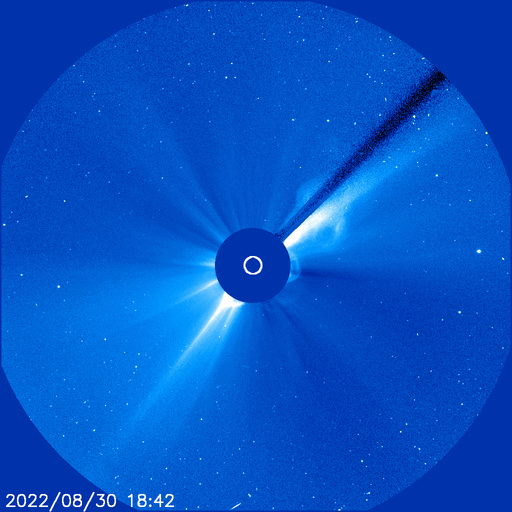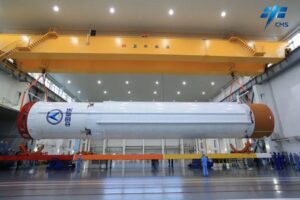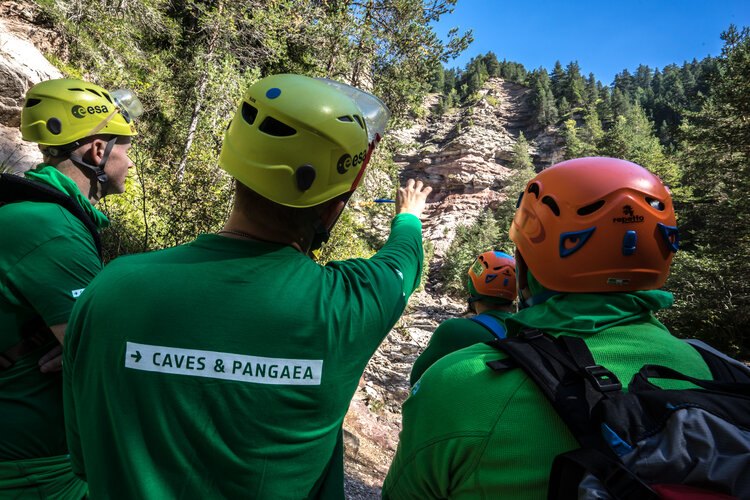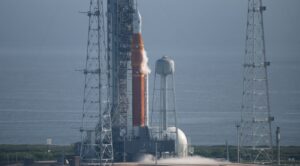Coronal mass ejection hits Solar Orbiter before Venus flyby
Monday, 05 September 2022 10:48
Duo undertake 7-hour spacewalk
Monday, 05 September 2022 08:59 Chinese astronauts on the Shenzhou XIV mission have carried out their first spacewalk, also known as an extravehicular activity, which finished early on Friday morning, according to the China Manned Space Agency.
Mission commander Senior Colonel Chen Dong opened an extravehicular activity hatch on the Tiangong space station at 6:26 pm on Thursday Beijing time and then floated out of the st
Chinese astronauts on the Shenzhou XIV mission have carried out their first spacewalk, also known as an extravehicular activity, which finished early on Friday morning, according to the China Manned Space Agency.
Mission commander Senior Colonel Chen Dong opened an extravehicular activity hatch on the Tiangong space station at 6:26 pm on Thursday Beijing time and then floated out of the st Everything is Dust in the Wind
Monday, 05 September 2022 08:59 Well, not quite. But for scientists like me, who study atmospheric and aeolian (wind-driven) processes, wind-blown dust is extremely important to understand on Mars. Because the Martian atmosphere is so thin, adding even a small amount of dust greatly increases the amount of sunlight absorbed, which greatly affects temperature, which in turn affects the entire atmospheric circulation.
Part
Well, not quite. But for scientists like me, who study atmospheric and aeolian (wind-driven) processes, wind-blown dust is extremely important to understand on Mars. Because the Martian atmosphere is so thin, adding even a small amount of dust greatly increases the amount of sunlight absorbed, which greatly affects temperature, which in turn affects the entire atmospheric circulation.
Part NASA awards LISA mission laser instrument contract
Monday, 05 September 2022 08:59 NASA has selected Ball Aerospace and Technology Corp. of Boulder, Colorado, to provide the Laser Prestabilizaton System (LPS) for the Laser Interferometer Space Antenna (LISA) laser assembly.
The total value of the cost-plus-fixed-fee contract is $11,906,675, and the period of performance is from Sept. 1, 2022, through April 1, 2025. The work will be performed at the contractor's facility
NASA has selected Ball Aerospace and Technology Corp. of Boulder, Colorado, to provide the Laser Prestabilizaton System (LPS) for the Laser Interferometer Space Antenna (LISA) laser assembly.
The total value of the cost-plus-fixed-fee contract is $11,906,675, and the period of performance is from Sept. 1, 2022, through April 1, 2025. The work will be performed at the contractor's facility Rocket to carry Mengtian space lab module arrives at launch site
Monday, 05 September 2022 08:59 A Long March-5B Y4 rocket, tasked with sending China's space station lab module Mengtian into orbit, has been transported to the Wenchang Spacecraft Launch Site in the southern province of Hainan, the China Manned Space Agency said Saturday.
The rocket will undergo final assembly and testing together with the Mengtian lab module, which arrived earlier.
Preparations for the launch mis
A Long March-5B Y4 rocket, tasked with sending China's space station lab module Mengtian into orbit, has been transported to the Wenchang Spacecraft Launch Site in the southern province of Hainan, the China Manned Space Agency said Saturday.
The rocket will undergo final assembly and testing together with the Mengtian lab module, which arrived earlier.
Preparations for the launch mis China begins launch campaign for final space station module
Monday, 05 September 2022 08:44
Work to assemble a Long March 5B heavy-lift rocket is underway at Wenchang spaceport as China prepares to complete the construction of its Tiangong space station.
The post China begins launch campaign for final space station module appeared first on SpaceNews.
Training astronauts to be scientists on the Moon
Monday, 05 September 2022 08:30
Astronauts with their sights on the Moon are receiving world-class geology training during the fifth edition of ESA’s Pangaea campaign. From choosing landing sites for a future Artemis mission, to designing science operations for the lunar surface, the course challenges space explorers to become field scientists.
NASA unsure next Moon rocket launch attempt possible this month
Sunday, 04 September 2022 12:00 After scrapping a second attempt to get its new 30-story lunar rocket off the ground due to a fuel leak, NASA officials said Saturday it may not be possible to try again this month.
The current launch window for NASA's Artemis 1 mission to the Moon ends Tuesday and is "definitely off the table," said Jim Free, associate administrator for Exploration Systems Development, at a press conference
After scrapping a second attempt to get its new 30-story lunar rocket off the ground due to a fuel leak, NASA officials said Saturday it may not be possible to try again this month.
The current launch window for NASA's Artemis 1 mission to the Moon ends Tuesday and is "definitely off the table," said Jim Free, associate administrator for Exploration Systems Development, at a press conference NASA will not try new Moon rocket launch attempt in coming days
Saturday, 03 September 2022 23:37 After scrapping a second attempt to get its new 30-story rocket off the ground due to a fuel leak, NASA announced on Saturday it will not try again during its current window of opportunity, which ends early next week.
Determined by the position of the Earth and Moon, the current launch period for NASA's Artemis 1 mission ends Tuesday and is "definitely off the table," said Jim Free, associat
After scrapping a second attempt to get its new 30-story rocket off the ground due to a fuel leak, NASA announced on Saturday it will not try again during its current window of opportunity, which ends early next week.
Determined by the position of the Earth and Moon, the current launch period for NASA's Artemis 1 mission ends Tuesday and is "definitely off the table," said Jim Free, associat Fuel leak ruins NASA's 2nd shot at launching moon rocket
Saturday, 03 September 2022 16:26
NASA's new moon rocket sprang another dangerous fuel leak Saturday, forcing launch controllers to call off their second attempt to send a crew capsule into lunar orbit with test dummies.
Leak ruins NASA moon rocket launch bid; next try weeks away (Update)
Saturday, 03 September 2022 16:26
NASA's new moon rocket sprang another dangerous fuel leak Saturday, forcing launch controllers to call off their second attempt to send a crew capsule into lunar orbit with test dummies.
NASA postpones rocket launch to Moon after fuel leak
Saturday, 03 September 2022 15:53 NASA on Saturday scrapped a second attempt to get its new 30-story rocket off the ground and send its uncrewed test capsule toward the Moon after engineers detected a fuel leak.
With millions around the globe and hundreds of thousands on nearby beaches waiting for the historic launch of the massive Space Launch System (SLS), a leak near the base of the rocket was found as ultra-cold liquid h
NASA on Saturday scrapped a second attempt to get its new 30-story rocket off the ground and send its uncrewed test capsule toward the Moon after engineers detected a fuel leak.
With millions around the globe and hundreds of thousands on nearby beaches waiting for the historic launch of the massive Space Launch System (SLS), a leak near the base of the rocket was found as ultra-cold liquid h Second Artemis 1 launch attempt scrubbed
Saturday, 03 September 2022 14:35
NASA called off a second attempt to conduct the inaugural launch of the Space Launch System Sept. 3 after failing to resolve a liquid hydrogen leak during fueling of the rocket.
NASA Moon rocket ready for second attempt at liftoff
Saturday, 03 September 2022 05:17 After technical issues halted its first launch attempt, NASA will try again on Saturday to get its new 30-story rocket off the ground and send its unmanned test capsule towards the Moon.
If the massive Space Launch System (SLS) lifts off successfully, it will not only be awe-inspiring but also historic for NASA, marking the first of its Artemis program plotting a return to the Moon, fifty ye
After technical issues halted its first launch attempt, NASA will try again on Saturday to get its new 30-story rocket off the ground and send its unmanned test capsule towards the Moon.
If the massive Space Launch System (SLS) lifts off successfully, it will not only be awe-inspiring but also historic for NASA, marking the first of its Artemis program plotting a return to the Moon, fifty ye It's raining diamonds across the universe, research suggests
Saturday, 03 September 2022 00:42 It could be raining diamonds on planets throughout the universe, scientists suggested Friday, after using common plastic to recreate the strange precipitation believed to form deep inside Uranus and Neptune.
Scientists had previously theorised that extremely high pressure and temperatures turn hydrogen and carbon into solid diamonds thousands of kilometres below the surface of the ice giants
It could be raining diamonds on planets throughout the universe, scientists suggested Friday, after using common plastic to recreate the strange precipitation believed to form deep inside Uranus and Neptune.
Scientists had previously theorised that extremely high pressure and temperatures turn hydrogen and carbon into solid diamonds thousands of kilometres below the surface of the ice giants 
